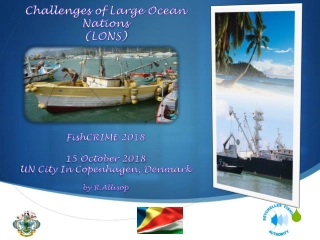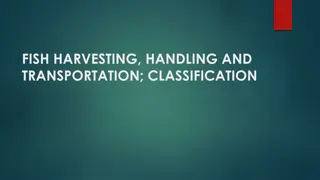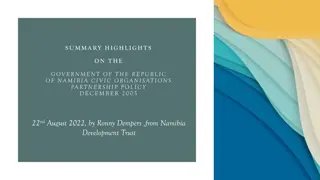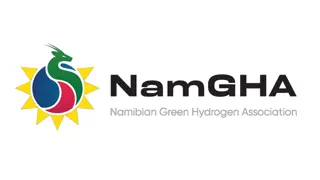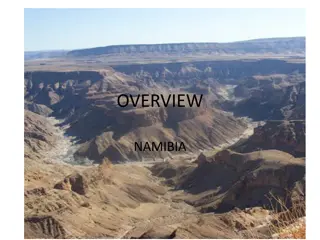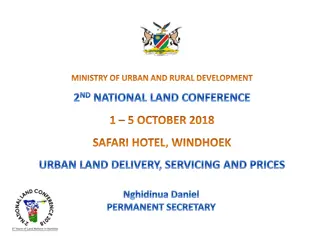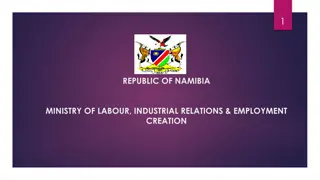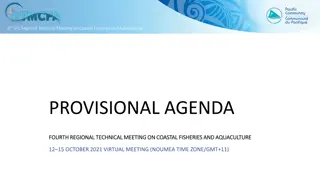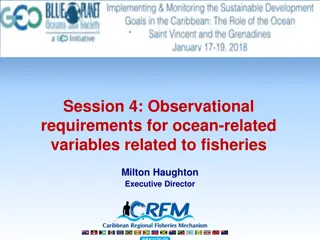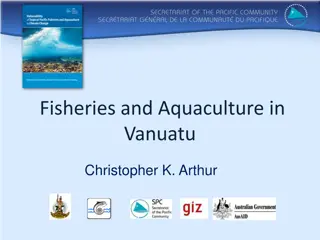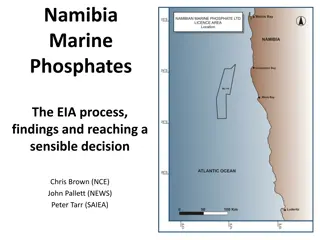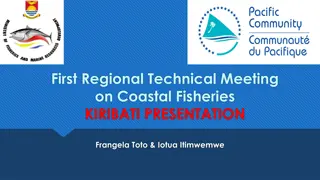Fisheries Industry in Namibia: A Productive Sector with Growth Potential
Namibia's fisheries industry is one of the most productive in the world, known for its commercial harvest of horse mackerel, hake, sardine, and monkfish. The country is a leading seafood producer in Africa, exporting mainly to the European Union. Managed by the Ministry of Fisheries and Marine Resources, the sector provides significant employment opportunities and contributes to the country's foreign exchange earnings. Despite challenges in financing and fleet efficiency, Namibia's marine resources remain relatively stable, offering great potential for further development and growth.
Download Presentation

Please find below an Image/Link to download the presentation.
The content on the website is provided AS IS for your information and personal use only. It may not be sold, licensed, or shared on other websites without obtaining consent from the author.If you encounter any issues during the download, it is possible that the publisher has removed the file from their server.
You are allowed to download the files provided on this website for personal or commercial use, subject to the condition that they are used lawfully. All files are the property of their respective owners.
The content on the website is provided AS IS for your information and personal use only. It may not be sold, licensed, or shared on other websites without obtaining consent from the author.
E N D
Presentation Transcript
Namibia fisheries country profile
Namibia Namibia fisheries fisheries country profile country profile - - summary summary Namibia has one of the most productive fishing grounds in the world Namibia is one of the largest seafood producers in Africa and has a modern fishing industry with a great potential for growth. The principal fish harvested for commercial purposes are horse mackerel, hake, sardine and monkfish - regulated through the allocation of a Total Allowable Catch (TAC) based on annually surveys. The total annual catch in 2013 was about 486 000 tonnes. The main species were horse mackerel (295 000 tonnes), hake (147 000 tonnes) and sardine (25 000 tonnes). (Poland in 2012 169 775 tonnes, In 2013, exports of fish and fishery products were valued at USD 787 million. Most of the horse mackerel is sold frozen in the African market, while the bulk of hake and monkfish production is exported to the European Union. (Poland in 2013 1.3 billion EUR) In 2013, imports of fish and fishery products were worth USD 46 million. (Poland in 2013 1.4 bilion EUR) Annual fish consumption amounted to an average of about 13.6 kg per capita in the last years. (Angola 14.7 kg, Poland 12 kg, Spain 42,9 kg) In 2013 about 15 000 persons were employed in the sector, the vast majority of whom are Namibians. The fishin industry plays a crucial role in production, foreign exchange earnings to the government, government revenue and employment. The only landing sites are Walvis Bay and Luderitz, with most of the processing plants and cold storage facilities located in Walvis Bay. Small-scale marine fisheries are insignificant due to the absence of settlements on the hyper-arid desert coast.
Namibia Namibia fisheries fisheries country profile country profile - - summary summary The responsibility for fisheries and aquaculture lies with the Ministry of Fisheries and Marine Resources (MFMR). Namibia s management regime of the marine resources - has allowed the stocks to remain relatively stable and promoted development in the fishing industry. Potential to increase export output and for upgrading production facilities. The marine fisheries sector is comprised of an ageing and inneficient fleet and requiers financig to replace. Lack of financing and expertise hampers the development of the aquaculture sector. Namibia cooperates with few countries (Finland, Spain, Cuba, Vietnam) e.g. in the field of stock assessment, navigation, research and data analysis and in the field of freshwater aquaculture techniques Namibia is Party to the 1982 UN Convention on the Law of the Sea since April 1983 and to the 1995 UN Fish Stocks Agreement since April 1998. In July 1995, Namibia became Party to the 1993 FAO Compliance Agreement
Membership in Regional Fishery Bodies Membership in Regional Fishery Bodies South East Atlantic Fisheries Organisation (SEAFO) International Commission for the Conservation of Atlantic Tunas (ICCAT) Ministerial Conference on Fisheries Cooperation Among African States Bordering the Atlantic (COMHAFAT-ATLAFCO) Commission for the Conservation of Antarctic Marine Living Resources (CCAMLR)
Main Main resources resources The principal stocks harvested for commercial purposes and regulated through the allocation of a Total Allowable Catch (TAC) and for which surveys are conducted annually to determine the status of the stocks are: a) horse mackerel b) the two species of hake, - the shallow water and deep water hakes c) sardine, d) monkfish, e) deep sea red crab, f) rock lobster.
Namibia Namibia - - Total (1000 (1000 tonnes tonnes) ) Total Allowable Allowable Catches Catches, 2006 , 2006- -2013 2013 SPECIES 2006 2007 2008 2009 2010 2011 2012 2013 Horse mackerel 360 360 230 230 247 310 320 350 Hake 130 130 130 135.5 140 180 170 140 Sardine 25 15 15 17 25 25 31 25 Monkfish 9.5 9.5 9.5 8.5 9 13 14 10 Crab 2.4 2.5 2.5 2.7 2.7 2.85 3.1 3.15 Rock lobster 0.420 0.350 0.350 0.350 0.275 0.350 0.350 0.350 Orange roughy 11 0.900 0.900 0 0 0 0 0 Source: MFMR statistical division.
Namibia Namibia - - Harvest of the main commercial species, Harvest of the main commercial species, 2006 2006- -2012 ( 2012 (tonnes tonnes) ) SPECIES 2006 2007 2008 2009 2010 2011 2012 Horse mackerel 309 980 201 660 186 996 215 051 185 673 210 160 184 795 Hake 137 771 125 534 117 286 137 312 127 196 149 816 138 432 Sardine 2 316 23 522 18 755 20 137 20 229 31 774 22 249 Monkfish 9 816 8 932 7 270 6 922 7 904 7 243 10 736 Crab 2 228 3 245 2 100 1 577 766 2 285 1 106 Rock lobster 285 153 195 43 82 166 87 Orange roughy 545 255 NA NA NA NA NA Tuna 2 903 4 596 3 281 4 241 2 024 4 655 2 442 Kingklip 4 493 4 366 3 424 4 380 4 810 3 045 4 559 Other fish species 39 891 40 408 12 973 15 791 12 917 29 340 15 872 Total fish harvest 510 228 412 671 352 280 405 454 361 601 438 484 380 278 Seals (Numbers) 83 045 34 728 47 603 41 145 47 821 67 764 22 249 Sources: MFMR statistical division.
Landing Landing sites sites The catches from the marine fishery are landed at: a) Walvis Bay - the majority of the landings due to its proximity to the major fishing grounds and easier access b) Luderitz
Fish Fish utilization utilization Horse mackerel is frozen at sea and mostly trans-shipped within port limits. Otherwise processing involves sun-drying and fishmeal production. Initiatives are also in progress to produce smoked and canned horse mackerel products. Hake is currently processed into: a) fresh fish on ice, b) frozen retail packs sold directly to end-consumers through retail outlets such as supermarkets, freezer food stores and European distributors, c) frozen catering packs, d) fish mince, blocks, sausages, roes, loins, portions and wings. Sardine is almost entirely canned. Rock lobster is processed ashore and product forms include cooked and frozen whole lobster and tails and also uncooked frozen whole lobster and tails. Tuna and large pelagics (swordfish, marlin, yellowfin tuna, bigeye tuna and shark) are headed and gutted, then blast frozen at sea.
Fish Fish markets markets Local markets Namibians are traditionally not fish eaters and the majority of the marine fisheries and mariculture products are exported to foreign markets. The main fish species in the local markets are unprocessed products such as horse mackerel, small size hake (baby hake),monkfish and dentex. Of these horse mackerel is the most popular because it is readily available, cheaper and easy to prepare.
Fish Fish markets markets International markets Fish exports accounted for around 13 % of total exports in Namibia. Namibia exports more than 90 % of its fisheries production in various product forms, primarily to international markets including: a) EU, - mostly hake, but also monkfish. The biggest importer is Spain, and in smaller quantity Portugal, France, Italy, Holland and Germany, b) South Africa the second largest importer. The major destination for sardine to where up to 85 % are exported in the form of canned products, c) USA - a small portion of the products, d) the Far East monkfish (Korea and Singapore), e) African markets horse mackerel (Democratic Republic of Congo, Angola, Mozambique 87% of exports. Ghana, Cameroon, Nigeria 10%. The remaining 3% is consumed locally).
Management applied to main fisheries Management applied to main fisheries The immediate objective of the Ministry of Fisheries following the country s independence was to rebuild the fisheries resources, which were previously overly exploited. In so doing the Ministry had to implement and has been maintaining a rigorous management system, which includes: a) a fishing right allocation system, b) a Total Allowable Catch (TAC) and c) a quota allocation system based on stock estimates from scientific surveys and stock assessment for all the target species, d) a Monitoring, Control, Surveillance (MCS) programme, including a Vessel Monitoring System (VMS) to protect and ensure compliance with the regulations, e) the prohibition of trawling in waters shallower than 200 meters where most of the spawning and nursery areas lie
Management Management measures arrangements arrangements measures and and institutional institutional Namibia is strongly opposed to the subsidy policies of other nations, both on the grounds that subsidies cause over-capitalization which leads to over-fishing, and because subsidies distort trade unfairly and thus the fishing industry in Namibia is not subsidized. A tax system, especially through the quota fees is instead in place. Fee rebates apply to Namibian vessels, Namibian crew and processing on-shore. The government directed a policy for the hake fishery aimed at promoting onshore processing. Overall, the Namibian fisheries did not benefit from manufacturing incentives and tax relief incentives offered to other industries in Namibia. However, there are considerable fuel rebates for Namibian companies according to criteria linked to the grade of operation, ownership, the flagging of the vessel and the employment share of Namibians. To support Namibianization and empowerment policies, fishing rights and quotas are given e. g. to Namibian-controlled ventures.
Socio Socio- -economic contribution of the fishery economic contribution of the fishery sector sector The fishing industry remains one of the highest contributors to Namibia s economy and is second in terms of export earnings and third in terms of contribution to GDP. The sector plays a crucial role in production, foreign exchange earnings to the government, government revenue and employment. Aquaculture on the other hand has a potential for employment creation and food security to Namibia s previously disadvantaged communities.
Employment Employment The marine fisheries with a total of 15 000 employees (2013) is the largest employer in the fisheries sector. the main branches where the workers are employed (approximately): a) 63 % of workers - in the hake industry, which has several onshore processing facilities in Luderitz and Walvis Bay and a large fleet of vessels, b) 230 workers in the monkfish fishery (on board of vessels), c) 2000 workers in the horse mackerel fishery Employment in the fishing industry has remained relatively stagnant over the past years with a decrease observed since 2010. Employment in the aquaculture sector remains minimal.
Employment Employment in the marine fisheries sector YEAR NUMBER 2009 13 305 2010 13 300 2011 10 797 2012 12 130 Source MFMR annual report 2011/12
Government and non Government and non- -government sector policies and development strategies policies and development strategies government sector The strategies for marine resources as stipulated in the Vision 2030 document are as follows: a) Setting TACs at conservative levels in order to promote the sustainable utilization of the marine resources and their recovery, b) Adopting and implementing all the policies and programmes in support of sustainability, c) Developing strategies that create incentives for fishing companies to adopt more sustainable fishing practices, d) Utilizing the services of expert consultants to assist Government fisheries scientists in setting their estimates for TACs, e) Continuing research, involving outside researchers, into the functioning of the marine environment and marine biodiversity, f) Developing new ways of adding value to Namibia s marine products, g) Improving awareness of market requirements for marine products, and monitor market responses to Namibian products, h) Identifying cost-effective, flexible and adaptable management approaches and national disaster response strategies to the potential impact of sea-level rise and other impacts linked to climate change, which could affect the marine resources sector; the Ministry also intends to increase the marine aquaculture production to 5 500 tonnes by 2030, through targeted intervention by government and industry to remove the key developmental constraints in this sector.
Research, education and training Research, education and training Research The Ministry of Fisheries and Marine Resources has three Research Institutes two focusing on marine fisheries and mariculture research - The Namibian Maritime and Fisheries Institute (NAMFI) and National Marine and Information Research Center (NatMIRC), and one focusing on inland fisheries and freshwater aquaculture research - Kamutjonga Inland Fisheries Institute (KIFI). The research conducted at the NatMIRC, situated in Swakopmund, focuses largely on fisheries and oceanographic surveys and the collection of biological parameters of the major commercial species through port sampling programmes. Surveys are conducted annually for hake, monkfish and deep-sea red crab whilst annual hydro-acoustic surveys are conducted for horse mackerel and sardine. Ageing programs are established to determine the age of the major species, which together with the data collected from the fishing industry and survey estimates is used for stock assessment purposes. Secondary production, chemical and physical oceanographic parameters and the state of the environment are also determined using the data collected during these surveys. Mariculture research programs include the monitoring of the mariculture farm water quality and testing of diseases in cultured oysters and alerting farmers to stop exports should algal blooms or any disease be detected.
Research, education and training Research, education and training Education and training Capacity development - funds are availed annually to enable staff members to be trained through short courses and qualifying studies each year. Training in maritime and fishing technology aspects is offered at the Namibian Maritime and Fisheries Institute (NAMFI). Over the years the training and technical assistance from various donor countries has been received and has greatly benefited the staff members. Collaboration through programs such as BENEFIT (The Benguela Environment Fisheries Interaction and Training Programme) and the BCLME (Benguela Current Large Marine Ecosystem) resulted in the development of research in the country and culminated in the formation of the Benguela Current Commission (Angola, Namibia, South Africa). In recent years training has been offered annually through the Benguela Current Commission in the fields of hydro-acoustics, stock assessment and ageing to develop the skills of the researchers in these fields. During the financial year that ended in March 2013, a total of 83 staff members received funding from the Ministry for training in short courses and 28 for qualifying studies, whilst another 30 attended various courses sponsored through foreign governments.
Foreign Foreign aid aid Namibia has been receiving very little donor assistance, particularly since the country s classification to an upper middle-income category in 2011. However after that, Namibia received the following foreign aid: a) 2012 Finland a new multidisciplinary research vessel through a concessionary loan by the Finnish Government b) 2012 Finland - a project focusing on training in the disciplines of oceanography, stock assessment and navigation. c) Cuba, Vietnam and FAO-funded projects - collaboration to enhance capacity in the field of freshwater aquaculture techniques. d) Spain - a project on several aspects of research and data analysis of marine fisheries resources.
Trends Trends, , issues Constraints issues and development and development The major challenges facing the Namibian fisheries and aquaculture sectors are identified by the Ministry of Fisheries and Marine Resources being as follows: a) External factors such as fuel prices and the volatile exchange rates curtail the performance of the fishing industry. b) The marine fisheries sector, especially the hake sub-sector, is comprised of a mostly ageing and inefficient fleet and requires financing to replace. However, the financial institutions are reluctant to take the right of exploitation as collateral. c) Lack of financing and expertise hampers the development of the aquaculture sector. Access to finances at realistic rates is crucial for the entrepreneurs to venture into aquaculture operations. d) Environmental conditions which affect the state of the stocks on which the TAC is based and on the catches of some of the fisheries such as rock lobster. e) High port charges especially at the harbour of Luderitz and for the seasonal purse seine fisheries. f) Conflicts with other sectors such as mining. Mining activities such as seismic exploration and diamond mining in the south are believed to have a negative impact of the catches of the highly migratory tuna and rock lobster fisheries. g) Both local and international financial institutions are reluctant to provide start-up capital. Lack of knowledge, high risk and lack of security are some of the reasons given by local banks.
Trends Trends, , issues Opportunities issues and development and development Namibia s management regime of the marine resources - has allowed the stocks to remain relatively stable and promoted development in the fishing industry. Potential for upgrading production facilities to incorporate new value added products, including secondary processed products such as breaded portions and microwave ready meals. Value addition could lead to higher earnings from exports of high quality products that command good prices in international markets. Potential to increase export output from fisheries through proper marketing research and new marketing development strategies. Need for the establishment of an export promoting body that will promote Namibian fish and fish products on international markets. Eco-labeling and MCS certification are some key instruments that can be used for branding and labeling purposes for products to penetrate new markets. The creation of the Small Medium Enterprise (SME) Development Bank is expected to provide capital to small scale aquaculture fish farmers and new entrepreneurs. Furthermore, the growing local markets as a result of the Ministry s incentives such as the fish consumption programme as well as regional markets, provide an opportunity for growth of production in the freshwater aquaculture sector


